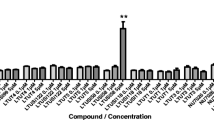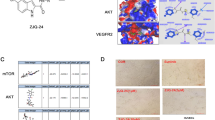Abstract
Hypoxia is a feature of all solid tumours, contributing to tumour progression. Activation of HIF-1α plays a critical role in promoting tumour angiogenesis and metastasis. Since its expression is positively correlated with poor prognosis for cancer patients, HIF-1α is one of the most convincing anticancer targets. BP-1T is a novel antiproliferative agent with promising antiangiogenic effects. In the present study, the molecular mechanism underlying cytotoxic/antiangiogenic effects of BP-1T on tumour/non-tumour angiogenesis was evaluated. Evidences show that BP-1T exhibits potent cytotoxicity with prolonged activity and effectively regressed neovessel formation both in reliable non-tumour and tumour angiogenic models. The expression of CoCl2-induced HIF-1α was inhibited by BP-1T in various p53 (WT)-expressing cancer cells, including A549, MCF-7 and DLA, but not in mutant p53-expressing SCC-9 cells. Mechanistically, BP-1T mediates the HIF-1α proteasomal degradation by activating p53/MDM2 pathway and thereby downregulated HIF-1α-dependent angiogenic genes such as VEGF-A, Flt-1, MMP-2 and MMP-9 under hypoxic condition of in vitro and in vivo solid tumour, eventually leading to abolition of migration and invasion. Based on these observations, we conclude that BP-1T acts on HIF-1α degradation through p53/MDM2 proteasome pathway.










Similar content being viewed by others
References
Cameliet P, Jain RK (2000) Angiogenesis in cancer and other disease. Nature 407(6801):249–257. doi:10.1038/35025220
Wang GL, Jiang BH, Rue EA, Semenza GL (1995) Hypoxia inducible factor 1 is a basic-helix-loop-helix-PAS heterodimer regulated by cellular O2 tension. Proc Natl Acad Sci USA 92(12):5510–5514. http://www.pnas.org/content/92/12/5510.long
Xia Y, Choi HK, Lee K (2012) Recent advances in hypoxia-inducible factor (HIF)-1 inhibitors. Eur J Med Chem 49:24–40. doi:10.1016/j.ejmech.2012.01.033
Dayan F, Mazure NM, Brahimi-Horn MC, Pouysségur J (2008) A dialogue between the hypoxia-inducible factor and the tumor microenvironment. Cancer Microenviron 1(1):53–68. doi:10.1007/s12307-008-0006-3
Semenza GL (2003) Targeting HIF1 for cancer therapy. Nat Rev Cancer 3(10):721–732. doi:10.1038/nrc1187
Hong SS, Lee H, Kim KW (2004) HIF-1α: a valid therapeutic target for tumor therapy. Cancer Res Treat 36(6):343–353. doi:10.4143/crt.2004.36.6.343
Forsythe JA, Jiang BH, Iyer NV, Agani F, Leung SW et al (1996) Activation of vascular endothelial growth factor gene transcription by hypoxia-inducible factor 1. Mol Cell Biol 16:4604–4613. doi:10.1128/MCB.16.9.4604
Ferrara N, Gerber HP, LeCouter J (2003) The biology of VEGF and its receptors. Nat Med 9:669–676. doi:10.1038/nm0603-669
Powis G, Kirkpatrick L (2004) Hypoxia inducible factor-1A as a cancer drug target. Mol Cancer Ther 3(5):647–654. http://mct.aacrjournals.org/content/3/5/647
Ke Q, Costa M (2006) Hypoxia-inducible factor-1 (HIF-1). Mol Pharmacol 70(5):1469–1480. doi:10.1124/mol.106.027029
Ravi R, Mookerjee B, Bhujwalla ZM, Sutter CH, Artemov D, Zeng Q et al (2000) Regulation of tumor angiogenesis by p53-induced degradation of hypoxia-inducible factor 1alpha. Genes Dev 14(1):34–44. doi:10.1101/gad.14.1.34
Zhou CH, Zhang XP, Liu F, Wang W (2015) Modeling the interplay between the HIF-1 and p53 pathways in hypoxia. Sci Rep 5:13834. doi:10.1038/srep13834
Amelio I, Inoue S, Markert EK, Levine AJ, Knight RA, Mak TW, Melino G (2015) TAp73 opposes tumor angiogenesis by promoting hypoxia-inducible factor 1α degradation. Proc Natl Acad Sci USA 112(1):226–231. doi:10.1073/pnas.1410609111
Joshi S, Singh AR, Durden DL (2014) MDM2 regulates hypoxic hypoxia inducible factor 1α stability in an E3 ligase, proteasome, and PTEN phosphatidyl inositol 3 kinase AKT dependent manner. J Biol Chem 289(33):22785–22797. doi:10.1074/jbc.M114.587493
Chen D, Li M, Luo J, Gu W (2003) Direct interactions between HIF-1 alpha and MDM2 modulate p53 function. J Biol Chem 78(16):13595–13598. doi:10.1074/jbc.C200694200
Shankar J, Thippegowda PB, Khanum SA (2009) Inhibition of HIF-1a activity by BP-1 ameliorates adjuvant induced arthritis in rats. Biochem Biophys Res Commun 387(2):223–228. doi:10.1016/j.bbrc.2009.01.086
Ranganatha VL, Vijay Avin BR, Thirusangu P, Prashanth T, Prabhakar BT, Khanum SA (2013) Synthesis, angiopreventive activity, and in vivo tumor inhibition of novel benzophenone–benzimidazole analogs. Life Sci 93(23):904–911. doi:10.1016/j.lfs.2013.10.001
Prabhakar BT, Khanum SA, Jayashree K, Salimath BP, Shashikanth S (2006) Antitumor and proapoptotic effect of novel synthetic benzophenone analogues in Ehrlich ascites tumor cells. Bioorg Med Chem 14(2):435–446. doi:10.1016/j.bmc.2005.08.039
Prabhakar BT, KhanumSA SS, Salimath BP (2006) Antiangiogenic effect of 2-benzoylphenoxy acetamide in EAT cell is mediated by HIF-1α and down regulation of VEGF of in-vivo. Invest N Drugs 24(6):471–478. doi:10.1007/s10637-006-6587-0
Vijay Avin BR, Thirusangu P, Ranganatha VL, Firdouse A, Prabhakar BT, Khanum SA (2014) Synthesis and tumor inhibitory activity of novel coumarin analogs targeting angiogenesis and apoptosis. Eur J Med Chem 75:211–221. doi:10.1016/j.ejmech.2014.01.050
Prashanth T, Thirusangu P, Vijay Avin BR, Ranganatha VL, Prabhakar BT, Khanum SA (2014) Synthesis and evaluation of novel benzophenone-thiazole derivatives as potent VEGF-A inhibitors. Eur J Med Chem 87:274–283. doi:10.1016/j.ejmech.2014.09.069
Xu LF, Ni JY, Sun HL, Chen YT, Wu YD (2013) Effects of hypoxia-inducible factor-1α silencing on the proliferation of CBRH-7919 hepatoma cells. World J Gastroenterol 19(11):1749–1759. doi:10.3748/wjg.v19.i11.1749
Bair AM, Thippegowda PB, Freichel M, Cheng N, Ye RD, Vogel SM, Yu Y, Flockerzi V, Malik AB, Tiruppathi C (2009) Ca2+ entry via TRPC channels is necessary for thrombin-induced NF-kappaB activation in endothelial cells through AMP-activated protein kinase and protein kinase Cdelta. J Biol Chem 284(1):563–574. doi:10.1074/jbc.M803984200
Franken NA, Rodermond HM, Stap J, Haveman J, van Bree C (2006) Clonogenic assay of cells in vitro. Nat Protoc 1(5):2315–2319. doi:10.1038/nprot.2006.339
Cory G (2011) Scratch-wound assay. Methods Mol Biol 769:25–30. doi:10.1007/978-1-61779-207-6_2
Tolboom TC, Huizinga TW (2007) In vitro matrigel fibroblast invasion assay. Methods Mol Med 135:413–421. doi:10.1007/978-1-59745-401-8_27
Sys GM, Lapeire L, Stevens N, Favoreel H, Forsyth R, Bracke M, De Wever O (2013) The in ovo CAM-assay as a xenograft model for sarcoma. J Vis Exp 17(77):e50522. doi:10.3791/50522
Olfa KZ, Jose L, Salma D, Amine B, Najet SA, Nicolas A et al (2005) Lebestatin, a disintegrin from Macrovipera venom, inhibits integrin-mediated cell adhesion, migration and angiogenesis. Lab Investig 85(12):1507–1516. doi:10.1038/labinvest.3700350
Rogers MS, Birsner AE, D’Amato RJ (2007) The mouse cornea micropocket angiogenesis assay. Nat Protoc 2(10):2545–2550. doi:10.1038/nprot.2007.368
Kruger EA, Duray PH, Tsokos MG et al (2000) Endostatin inhibits microvessel formation in the ex vivo rat aortic ring angiogenesis assay. Biochem Biophys Res Commun 268(1):183–191. doi:10.1006/bbrc.1999.2018
Vijay Avin BR, Prabhu T, Ramesh CK, Vigneshwaran V, Riaz M, Jayashree K, Prabhakar BT (2014) New role of lupeol in reticence of angiogenesis, the cellular parameterof neoplastic progression in tumorigenesis models through altered gene expression. Biochem Biophys Res Commun 448(2):139–144. doi:10.1016/j.bbrc.2014.04.090
Hegde M, Karki SS, Thomas E, Kumar S, Panjamurthy K, Ranganatha SR, Rangappa KS, Choudhary B, Raghavan SC (2012) Novel levamisole derivative induces extrinsic pathway of apoptosis in cancer cells and inhibits tumor progression in mice. PLoS One 7(9):e43632. doi:10.1371/journal.pone.0043632
Zheng Y, Ni Y, Huang X, Wang Z, Han W (2013) Overexpression of HIF-1α indicates a poor prognosis in tongue carcinoma and may be associated with tumour metastasis. Oncol Lett 5(4):1285–1289. doi:10.3892/ol.2013.1185
Jayasooriya RG, Lee YG, Kang CH, Lee KT, Choi YH, Park SY, Hwang JK, Kim GY (2013) Piceatannol inhibits MMP-9-dependent invasion of tumor necrosis factor-α-stimulated DU145 cells by suppressing the Akt-mediated nuclear factor-κB pathway. Oncol Lett 5(1):341–347. doi:10.3892/ol.2012.968
Brown JM, Giaccia AJ (1998) The unique physiology of solid tumours: opportunities (and problems) for cancer therapy. Cancer Res 58(7):1408–1416. http://cancerres.aacrjournals.org/content/58/7/1408
Singh RP, Agarwal R (2004) A cancer chemopreventive agent silibinin, targets mitogenic and survival signaling in prostate cancer. Mutat Res 555(1–2):21–32. doi:10.1016/j.mrfmmm.2004.05.017
De Castro G, Jr AA (2006) Side effects of anti-cancer molecular-targeted therapies (not monoclonal antibodies. Curr Opin Oncol 18(4):307–315. doi:10.1097/01.cco.0000228733.55132.ea
Gurupadaswamy HD, Thirusangu P, Vijay Avin BR, Vigneshwaran V et al (2014) DAO-9 (2,5-di(4-aryloylaryloxymethyl)-1,3,4-oxadiazole) exhibits p53 induced apoptogenesis through caspase-3 mediated endonuclease activity in murine carcinoma. Biomed Pharmacother 68(6):791–797. doi:10.1016/j.biopha.2014.07.004
Al-Ghorbani M, Thirusangu P, Gurupadaswamy HD, Girish V, Neralagundi HGS, Prabhakar BT, Khanum SA (2016) Synthesis and antiproliferative activity of benzophenone tagged pyridine analogues towards activation of caspase activated DNase mediated nuclear fragmentation in Dalton’s lymphoma. Bioorg Chem 65:73–81. doi:10.1016/j.bioorg.2016.02.001
Johnston RL, Wockner L, McCart Reed AE, Wiegmans A, Chenevix-Trench G et al (2016) High content screening application for cell-type specific behaviour in heterogeneous primary breast epithelial subpopulations. Breast Cancer Res 18(1):18. doi:10.1186/s13058-016-0681-9
Jubb AM, Harris AL (2010) Biomarkers to predict the clinical efficacy of bevacizumab in cancer. Lancet Oncol 11(12):1172–1183. doi:10.1016/S1470-2045(10)70232-1
Ferrara N (2002) VEGF and the quest for tumour angiogenesis factors. Nat Rev Cancer 2(10):795–803. doi:10.1038/nrc909
Folkman J (1972) Anti-angiogenesis: new concept for therapy of solid tumors. Ann Surg 175(3):409–416
Bhat TA, Singh RP (2008) Tumor angiogenesis—a potential target in cancer chemoprevention. Food Chem Toxicol 46(4):1334–1345. doi:10.1016/j.fct.2007.08.032
Al-Ghorbani M, Vigneshwaran V, Ranganatha VL, Prabhakar BT, Khanum SA (2015) Synthesis of oxadiazole–morpholine derivatives and manifestation of the repressed CD31 microvessel density (MVD) as tumoral angiogenic parameters in Dalton’s Lymphoma. Bioorg Chem 60:136–146. doi:10.1016/j.bioorg.2015.04.008
Talmadge JE, Singh RK, Fidler IJ, Raz A (2007) Murine models to evaluate novel and conventional therapeutic strategies for cancer. Am J Pathol 170(3):793–804. doi:10.2353/ajpath.2007.060929
Jin Y, Wang H, Liang X, Ma J, Wang Y (2014) Pathological and prognostic significance of hypoxia-inducible factor 1alpha expression in epithelial ovarian cancer: a meta-analysis. Tumour Biol 35(8):8149–8159. doi:10.1007/s13277-014-2059-x
Myllyharju J (2013) Prolyl 4-hydroxylases, master regulators of the hypoxia response. Acta Physiol (Oxf) 208(2):148–165. doi:10.1111/apha.12096
Bratslavsky G, Sudarshan S, Neckers L, Linehan WM (2007) Pseudohypoxic pathways in renal cell carcinoma. Clin Cancer Res 13(16):4667–4671. doi:10.1158/1078-0432.CCR-06-2510
An WG, Kanekal M, Simon MC, Maltepe E, Blagosklonny MV, Neckers LM (1998) Stabilization of wildtype p53 by hypoxia-inducible factor 1α. Nature 392(6674):405–408. doi:10.1038/32925
Zhang H, Zhang Z, Xu Y, Xing L, Liu J, Li J, Tan Q (2004) The expression of hypoxia inducible factor 1-alpha in lung cancer and its correlation with p53 and VEGF. J Huazhong Univ Sci Technol Med Sci 24(2):124–127. doi:10.1007/BF02885408
Fan L, Li J, Yu Z, Dang X, Wang K (2014) The hypoxia-inducible factor pathway, prolyl hydroxylase domain protein inhibitors, and their roles in bone repair and regeneration. Biomed Res Int 2014:239356. doi:10.1155/2014/239356
Schmid T, Zhou J, Brüne B (2004) HIF-1 and p53: communication of transcription factors under hypoxia. J Cell Mol Med 8(4):423–431. doi:10.1111/j.1582-4934.2004.tb00467.x
Sermeus A, Michiels C (2011) Reciprocal influence of the p53 and the hypoxic pathways. Cell Death Dis 2:e164. doi:10.1038/cddis.2011.48
Brown JM (2007) Tumor hypoxia in cancer therapy. Methods Enzymol 35:297–321. doi:10.1016/S0076-6879(07)35015-5
Semenza GL (2013) HIF-1 mediates metabolic responses to intratumoral hypoxia and oncogenic mutations. J Clin Invest 123(9):3664–3671. doi:10.1172/JCI67230
Vigneshwaran V, Thirusangu P, Madhusudana S, Krishna V, Pramod SN, Prabhakar BT (2016) The latex sap of the ‘Old World Plant’ Lagenaria siceraria with potent lectin activity mitigates neoplastic malignancy targeting neovasculature and cell death. Int Immunopharmacol 39:158–171. doi:10.1016/j.intimp.2016.07.024
Lu P, Takai K, Weaver VM, Werb Z (2011) Extracellular matrix degradation and remodeling in development and disease. Cold Spring Harb Perspect Biol 3(12):1–24. doi:10.1101/cshperspect.a005058
Ryan HE, Poloni M, McNulty W et al (2000) Hypoxia-inducible factor-1a is a positive factor in solid tumor growth. Cancer Res 60(15):4010–4015. http://cancerres.aacrjournals.org/content/60/15/4010.long
Acknowledgments
B.T. Prabhakar gratefully acknowledges the grant extended by DBT (6242-P37/RGCB/PMD/DBT/PBKR/2015), UGC (F.No.41-507/2012 (SR) and VGST (VGST/GRD231/CISEE/2013-14). B.T. Prabhakar expresses sincere thanks to UGC, Government of India for Raman post doctoral research internship at Medical University South Carolina (MUSC), Charleston, USA. Prabhu Thirusangu acknowledges the Lady Tata Memorial Trust (LTMT) (JRS/2014-15/LTMT dated 11-08-2014), Mumbai, for financial assistance and support. Shaukath Ara Khanum expresses their sincere gratitude to VGST [VGST/CISEE/2012-13/2882], Government of Karnataka for the financial assistance and support.
Author information
Authors and Affiliations
Corresponding author
Ethics declarations
Conflict of interest
The authors declare that there are no conflicts of interest.
Electronic supplementary material
Below is the link to the electronic supplementary material.
Rights and permissions
About this article
Cite this article
Thirusangu, P., Vigneshwaran, V., Prashanth, T. et al. BP-1T, an antiangiogenic benzophenone-thiazole pharmacophore, counteracts HIF-1 signalling through p53/MDM2-mediated HIF-1α proteasomal degradation. Angiogenesis 20, 55–71 (2017). https://doi.org/10.1007/s10456-016-9528-3
Received:
Accepted:
Published:
Issue Date:
DOI: https://doi.org/10.1007/s10456-016-9528-3




